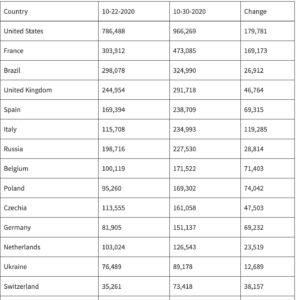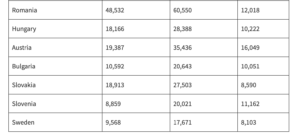On October 22, the European Centre for Disease Prevention and Control (ECDC) recorded the first day where the number of new COVID-19 cases globally surpassed five million (5,042,415). In just eight days, on October 30, the ECDC reports the fourteen day total shooting past six million new cases (6,093,987), an increase of 1,051,572 or 20.85% in eight days! As reviewed in a post on October 22, the U.S. and Europe were major factors in hitting five million and continue to be the major causes of the continued rapid escalation in global cases. See October 22, 2020, COVID-19 new cases over last 14 days pass 5,000,000 for first time on October 22, https://currentthoughtsontrade.com/2020/10/22/covid-19-newcases-over-last-14-days-pass-5000000-for-first-time-on-october-22/ .
The table below shows the fourteen day totals for selected countries as of October 22 and October 30 and the change in new cases. These twenty-one countries show an increase in eight days of 1,052,784 new cases or more than the global total. The 21 countries accounted for 2,756,890 new cases for the fourteen days ending October 22 or 54.67% of the global total at that time. For the fourteen days ending October 30, the 21 countries accounted for 3,809,674 new cases or 62.52% of the global total.


While the United States has the largest absolute increase in the last eight days for a single country, the vast majority of the increase flows from countries within the European Union. With the exception of Brazil and the United States, the rest of the countries in the chart are from Europe, most from the EU.
It is little wonder, then, that the EU and the UK, with dramatic growth in the number of new cases, are imposing renewed restrictions at least in many countries. While health care is handled by the individual countries within the the EU, the EU has been advocating better coordination and maintaining trade flows within the Community as countries come to grips with the current wave. See, e.g., Politico, October 30, 2020, EU leaders link arms for long fight against virus, https://www.politico.eu/article/eu-leaders-linkarms-for-long-fight-against-virus/ .
In the United States, the number of new cases is spiking again, with a new record recorded in the last day, with over 91,000 new cases and with predictions of new cases topping 100,000 each day in the next week or so.
Other parts of the world are not experiencing a second wave to the same extent, although much of the Americas remain at very high levels of new cases. Some major countries who have been seriously hit in recent months are seeing substantial reductions in new cases. India is the leading example — on October 22, the last 14 days showed 871,291 new cases; on October 30, for the last 14 days new cases were down to 718,383.
Conclusion
The top priority for many countries around the world is getting the COVID-19 pandemic under control. The costs in terms of human life and serious health problems are enormous. So too the costs to the global economy from taking the steps necessary to address the pandemic are enormous. How to address the pandemic and how to work internationally to secure a return to normalcy and a return to sustainable economic growth are the challenges for all governments and international organizations, including the WTO, WHO, IMF, World Bank and many others. The fact that the number of new cases is continuing to surge globally ten months after the start of global surveillance is obviously troubling and delays the return to normalcy. While some individual countries have gained control of the pandemic and others are making significant strides to reduce the number of new cases, “no one is safe until all are safe”. We have a long road to travel, and the western developed world is currently the major hot spot, struggling with the current extraordinary surge. We still are not in sight of a global peak and the rest of 2020 is likely to continue to stress global capabilities.
Terence Stewart, former Managing Partner, Law Offices of Stewart and Stewart, and author of the blog, Current Thoughts on Trade.
To read the original blog, click here.
